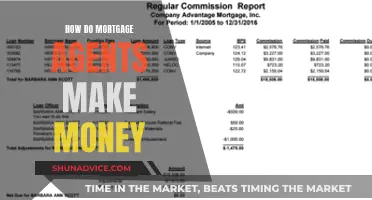
A mortgage agreement is a legally binding contract between a borrower and a lender, outlining the terms and conditions of a loan. It is a pledge by the borrower to relinquish their claim to the property if they cannot pay back the loan. The agreement places a lien on the property, allowing the lender to sell it if the borrower fails to meet the terms. A mortgage agreement is not the loan itself but serves as security for the lender. It is a crucial document when purchasing property, as it guarantees the loan and protects both parties. This article will provide a step-by-step guide on how to write a comprehensive mortgage agreement, covering all the essential elements that need to be included.
| Characteristics | Values |
|---|---|
| Purpose | To pledge to relinquish claim to the property if the loan cannot be paid back |
| Involves | Borrower and lender |
| Property | Real estate |
| Lender | Usually a bank or financial institution |
| Security | Allows the lender to recover the property if the borrower fails to pay |
| Agreement | The borrower agrees to give the lender a lien on the property |
| Details | Property description, unique mortgage covenants, repayment terms, loan amount, prepayment details, consequences of default, details about guarantors |
| Legal protection | File the agreement with the County Recorder's Office or County Clerk's Office |
What You'll Learn

The agreement's purpose and the parties involved
A mortgage agreement is a legally binding contract between a borrower and a lender. The borrower is usually an individual or individuals, and the lender is typically a bank or financial institution. The purpose of the agreement is to set out the terms and conditions of the loan, including the loan amount, repayment terms, and the consequences of any default by the borrower.
The agreement outlines the borrower's pledge to relinquish their claim to the property if they cannot pay back the loan. It is not the loan itself but a lien on the property, providing security to the lender. This means that the lender has a legal claim on the property and can sell it if the borrower fails to meet the terms of the agreement. The mortgage agreement serves as a guarantee of the loan and provides an incentive for the borrower to repay it.
The parties involved in a mortgage agreement are the borrower, also known as the mortgagor, and the lender, known as the mortgagee. The mortgagor is the party taking out the loan to purchase real estate property, while the mortgagee is the party providing the loan. The mortgagee grants the loan to the mortgagor with the expectation of repayment, including principal and interest, as well as any other relevant charges and fees.
In addition to the borrower and the lender, there may be other parties involved in the mortgage agreement process. For example, a trustee may hold the borrower's title in escrow until they meet their payment obligations. If the borrower defaults, the trustee can initiate foreclosure on behalf of the lender. Furthermore, witnesses may be required to sign the agreement, and legal counsel is often involved to ensure that the agreement is fair and understood by both parties.
Selling Your Owner-Financed Mortgage: Exploring Your Options
You may want to see also

The loan amount and interest
Firstly, the mortgage agreement should clearly state the loan amount, also known as the principal amount. This is the total value of the money being lent by the lender to the borrower for the purchase of the property. Specifying the loan amount in the agreement ensures that both parties are aware of the exact sum being borrowed and sets the foundation for the subsequent repayment terms.
Secondly, the interest rate applied to the loan should be defined. The interest rate represents the additional cost of borrowing the money, calculated as a percentage of the outstanding balance. It is essential to specify whether the interest rate is fixed or variable. A fixed interest rate remains constant throughout the loan term, while a variable interest rate may fluctuate over time based on market conditions or predetermined adjustment periods.
Additionally, the mortgage agreement should address the repayment terms, including the frequency of payments, the amount to be paid at each interval, and the total repayment period. The borrower must understand their payment obligations, including the principal and interest portions of each payment. The agreement may also specify any prepayment options, allowing the borrower to make additional payments or repay the loan in full before the end of the term.
Furthermore, it is important to outline the consequences of non-payment or default. This includes penalties such as late fees and the legal remedies available to the lender, such as foreclosure or repossession of the property. By clearly stating these consequences, the agreement provides an incentive for the borrower to adhere to the repayment schedule and protects the lender's interests in the event of non-compliance.
Finally, the mortgage agreement should include a section for signatures and dates from both the borrower and the lender, as well as any witnesses, to indicate their understanding and acceptance of the terms related to the loan amount and interest.
Maximizing Mortgage Savings: Strategies for Financial Freedom
You may want to see also

Repayment terms
Firstly, specify the loan amount, also known as the principal amount. Clearly state the total sum of money that the borrower is receiving from the lender. This principal amount serves as the foundation for calculating interest and other associated charges.
Next, outline the repayment schedule. Detail the frequency of payments, such as whether they are monthly, quarterly, or on a different timeline. Additionally, specify the date on which the first payment is due and the expected payment dates thereafter. It is also essential to include information on where and how the payments should be made, such as the lender's preferred payment method.
Interest rates and calculations are another crucial aspect of repayment terms. Define the interest rate that will be applied to the outstanding principal balance. This rate may be fixed or variable, and it should be clearly stated in the agreement. Additionally, provide a formula or method for calculating the interest, ensuring transparency in how the interest accrues over time.
Include any prepayment options or restrictions. Specify if the borrower has the flexibility to make additional payments or repay the loan in a lump sum before the scheduled due date. Outline any penalties or fees associated with early repayment, as these terms can vary depending on the lender's preferences and legal requirements.
Detail the consequences of late or missed payments. Clearly state the penalties that will be imposed if the borrower fails to make timely payments. This can include late fees, additional interest, or other charges. Additionally, describe the process that will be followed if the borrower defaults on the loan, including the legal remedies available to the lender, such as foreclosure or other collection actions.
Finally, consider including a section on guarantors or successors. This section should outline the responsibilities of any guarantors who promise to repay the loan in the event that the borrower fails to do so. It should also address who will be responsible for the loan if something happens to the borrower, such as their death or incapacitation.
Viewing Your Wintrust Mortgage Statement: A Step-by-Step Guide
You may want to see also

What happens if the borrower defaults
Defaulting on a mortgage is a stressful experience, and borrowers should be aware of the consequences. Firstly, it is important to note that a mortgage agreement is a pledge by a borrower that they will give up their claim to the property if they cannot pay their loan. A mortgage agreement is not the loan itself; it is a lien on the property, providing security to the lender.
If a borrower defaults on their mortgage, they will face a range of issues. Firstly, they will likely be charged various fees, including late fees, property inspection fees, maintenance expenses, and foreclosure costs. These fees can add up quickly, and the default will also damage the borrower's credit score, making it harder to qualify for future loans.
The most significant consequence of defaulting on a mortgage is the risk of losing one's home through foreclosure. The lender can take possession of the property and sell it to recover the loan balance. However, this is not an immediate process, and borrowers have several options to avoid foreclosure. They can contact their lender as soon as they anticipate missing a payment to discuss options, such as refinancing or loan modification, which can lower monthly payments. Borrowers may also qualify for mortgage forbearance, which temporarily reduces or pauses monthly payments while a new repayment plan is worked out.
In the case of foreclosure, the borrower will likely have to wait several years before applying for another mortgage, as the foreclosure will remain on their credit report. However, there are ways to prevent this outcome. The Department of Housing and Urban Development (HUD) offers counseling services to help borrowers evaluate their financial situation and find solutions to prevent default. Additionally, state and federal programs assist borrowers at risk of defaulting.
Unemployment and Your Mortgage: Strategies for Survival
You may want to see also

The property description
A mortgage agreement is a legally binding contract between a borrower and a lender, outlining the terms and conditions of a loan. It is important to note that a mortgage agreement is not the loan itself but a lien on the property, acting as a security measure for the lender. In the event that the borrower cannot meet the terms of the loan, the lender can take possession of the property.
Firstly, the location of the property should be clearly stated, including the full address, city, state, and country. This ensures there is no ambiguity regarding the property's whereabouts.
Secondly, provide a comprehensive description of the property's physical characteristics. This should include details such as the type of property (e.g., house, apartment, condominium), the number of bedrooms and bathrooms, the square footage or meterage, and any unique features or improvements. Be sure to mention any permanent fixtures and fittings that are included in the sale, such as built-in appliances or custom cabinetry.
Additionally, it is important to describe the property's condition at the time of the agreement. This should include any known defects, damages, or necessary repairs. A detailed description of the property's current state helps protect both the borrower and the lender in the event of future disputes.
Lastly, it is advisable to include a clear and concise legal description of the property. This may involve referencing the property's deed, parcel number, or other unique identifying information. By including this information, you ensure that the property is unambiguously identified and that the mortgage agreement complies with legal requirements.
In summary, the property description in a mortgage agreement should be detailed, accurate, and comprehensive. It should leave no room for ambiguity and provide a clear understanding of the property's location, characteristics, condition, and legal status. By providing a thorough property description, both the borrower and the lender can make informed decisions and protect their interests.
Verify Your Wells Fargo Mortgage: A Step-by-Step Guide
You may want to see also
Frequently asked questions
A mortgage agreement is a written document that officially recognises a legally binding relationship between a borrower and a lender. It outlines the loan's terms and conditions, including the loan amount, repayment terms, and what happens if the borrower defaults.
A mortgage agreement includes the total value of the money lent, the terms for repayment, and what happens in the event of a default. It also includes basic information about the parties involved and the property being transferred.
A mortgage agreement provides security to the lender by putting a lien on the property. This allows the lender to sell the property if the borrower can't meet the terms of the loan. It also helps to guarantee the loan and protect the lender's investment.







